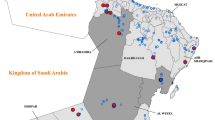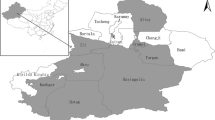Abstract
Paratuberculosis is caused by Mycobacterium avium subspecies paratuberculosis (MAP), a chronic disease of a negative economic impact on sheep production. In the state of Sonora, Mexico, there are no reports on the prevalence of MAP in sheep and risk factors associated with it. The objective of this study was to estimate the seroprevalence of MAP and risk factors associated by testing antibody-positive in sheep flocks located in the arid and hot region of Sonora, Mexico. A cross-sectional study was conducted from February 2012 to December 2014, in 43 flocks. Serum samples from 1178 individual sheep were obtained to detect antibodies against MAP by immunodiffusion in agar-gel. During blood sampling, information about animal and flock management risk factors were obtained by applying a questionnaire to the owners. Risk factors associated with seroprevalence of MAP were estimated using binary logistic regression. The true prevalence of MAP was 7.48% (95% CI 5.98, 8.98) and 53.5% of flocks had at least one seropositive animal. An animal was more likely to be seropositive if it was from a large flock (> 300 animals; OR 3.52, 95% CI 1.24, 9.99) and was born outside the farm (OR 6.24; 95% CI 2.9-1, 3.52). This is the first report of Mycobacterium avium subspecies paratuberculosis seroprevalence in sheep, in Sonora, Mexico. Large flocks and the entry of new animals to the flock were critical risk factors associated with MAP seropositivity.
Similar content being viewed by others
References
Atreya R., Bülte M., Gerlach G., Goethe R., Hornef M.W., Köhler H., Meens J., Möbius P., Roeb E., Weiss S. 2014. Facts, myths and hypotheses on the zoonotic nature of Mycobacterium avium subspecies paratuberculosis. International Journal of Medical Microbiology, 304(7): 858-867.
Bull T.J., Hermon-Taylor J., Pavlik I., El-Zaatari F., Tizard M. 2000. Characterization of IS900 loci in Mycobacterium avium subsp. paratuberculosis and development of multiplex PCR typing. Microbiology. 146:2185-2197.
Clarke, C.J., 1997. The pathology and pathogenesis of paratuberculosis in ruminants and other species. J. Comp Pathol. 116: 217–261.
Coelho A.C., Pinto M.L., Coelho A.M., Aires A. and Rodríguez J. 2010. A seroepidemiological survey of Mycobacterium avium subsp. paratuberculosis in sheep from North of Portugal. Pesq. Vet. Bras. 30(11): 903-908.
Correa-Muñoz, M., Medina-Basulto, G., Rentería-Evangelista, T., Monge-Navarro, F., González-Vizcarra, V. and López-Valencia, G. 2013. Molecular characterization of Mycobacterium avium subspecies paratuberculosis from sheep and cattle in Mexicali, Baja California, Mexico. Revista mexicana de ciencias pecuarias. 4(4):489-500. http://www.scielo.org.mx/scielo.php?script=sci_arttext&pid=S2007-11242013000400006&lng=es&tlng=es.
Dhand N.K., Eppleston J., Whittington R.J., Toribio J.A. 2009. Association of farm soil characteristics with ovine Johne’s disease in Australia. Preventive Veterinary Medicine. 89: 110–120.
Dieguez F.J., Arnaiz I., Sanjuán M.L., Vilar M.J., Yus E. 2008. Management practices associated with Mycobacterium avium subspecies paratuberculosis infection and the effects of the infection on dairy herds. Vet. Rec, 162:614-617.
Estévez-Denaives, I., Hernández-Castro, R., Trujillo-García, A.M., and Chávez-Gris, G. 2007. Detection of Mycobacterium avium subsp. paratuberculosis in goat and sheep flocks in Mexico. Small Ruminant. 72(2-3): 209-213.Research. https://doi.org/10.1016/j.smallrumres.2006.10.017
Favila-Humara L.C., Gilberto G., Chávez-Gris, Erika M. Carrillo-Casas, and Rigoberto Hernández-Castro. 2010. Mycobacterium avium subsp. paratuberculosis detection in individual and bulk tank miilk samples from bovine herds and caprine flocks. Foodborne Pathogens and Disease. 7:4, 351-355. https://doi.org/10.1089/fpd.2009.0374
Félix, P., Jiménez, G., Grageda, J., Quintana, J., Ortíz, J., y Leyva, J. (2008). Comportamiento histórico y tendencia del clima en la zona agrícola y pecuaria del sur de Sonora. Expectativas ante un cambio climático. Instituto Nacional de Investigaciones Forestales Agricolas y Pecuarias (INIFAP). Libro técnico No. 4. ISBN 978-607-425-109-8. http://biblioteca.inifap.gob.mx:8080/jspui/handle/123456789/1679. Accessed 12 March 2019.
Fernández-Silva J.A., Correa-Valencia N.M. and Ramírez N.F. 2014. Systematic review of the prevalence of paratuberculosis in cattle, sheep, and goats in Latin America and the Caribbean. Trop. Anim. Health Prod. 46:1321–1340.
Gwozdz J.M., Reichel M.P., Murray A., Manketelow W., West D.M. and Thompson K.G. 1997. Detection of Mycobacterium avium subspecies paratuberculosis in ovine tissues and blood by polymerase chain reaction. Vet Microbiol. 51: 233–244.
Harris N.B. and Barletta R.G. 2001. Mycobacterium avium subsp. paratuberculosis in Veterinary Medicine. Clin Microbiol Rev., 14(3):489-512.
Jaimes, N.G., Santillán Flores M.A., Hernández Cruz O.A., Córdova López D., Guzmán Ruiz C.C., Arellano Reynoso B., Díaz Aparicio E., Tenorio Gutiérrez V.R. and Cuéllar Ordaz A., 2008. Detection of Mycobacterium avium subspecies paratuberculosis by nested-PCR of ovine fecal samples. Veterinaria México, 39(4), 377-386. http://www.scielo.org.mx/scielo.php?script=sci_arttext&pid=S0301-50922008000400002&lng=es&tlng=en
Mainar-Jaime R.C. and Vázquez-Boland J.A. 1998. Factors associated with seroprevalence to Mycobacterium paratuberculosis in small-ruminant farms in the Madrid region (Spain). Prev. Vet. Med. 34: 317–327.
Mejía-Martínez, K., Lemus-Flores, C., González-Morteo, C.A., Palomares-Resendiz, G., Díaz-Aparicio, E., Gutiérrez-Hernández, J.L., 2017. Factores de riesgo asociados a Mycobacterium avium subespecie paratuberculosis en rebaños ovinos de Nayarit, México. Revista Científica FCV (LUZ) 27 (5): 294-302. http://www.redalyc.org/articulo.oa?id=95953315005
Milián-Suazo, F., Santillán-Flores, M.A., Zendejas-Martínez, H., García-Casanova, L., Hernández-Andrade, L. and Cantó-Alarcón, G.J., 2015. Prevalence and associated risk factors for Mycobacterium avium subsp. paratuberculosis in dairy cattle in Mexico. Journal of Veterinary Medicine and Animal Health. 7(10): 302–307.
Morón-Cedillo FJ., Cortez-Romero C., Gallegos-Sánchez J, Figueroa-Sandoval B., Aquino-Pérez G. y Amante-Orozco A. 2013. Prevalencia de la infección por Mycobacterium Avium subespecie paratuberculosis en rebaños de ovinos de dos municipios de San Luís Potosí, México. Revista Científica. FCV-LUZ. Vol. XXIII, No.4, 293–299. https://www.redalyc.org/articulo.oa?id=959/95926991008
Noordhuizen, J.P.T.M., Frankena, K., van der Hoofd, C.M., Graat, E.A.M. (Eds.), 1997. Application of quantitative methods in veterinary epidemiology. Wageningen Pers, The Netherlands, 445 pp.
Obasanjo I., Grohn Y.T., Mohammed H.O. 1997. Farm factors associated with the presence of Mycobacterium paratuberculosis infection in dairy herds on the New York State paratuberculosis control program. Prev Vet Med, 32: 243–251.
Phythian, C. J., D. Hughes, E. Michalopoulou, P. J. Cripps and J. S. Duncan. 2012. Reliability of body condition scoring of sheep for cross-farm assessments. Sm Rumin Res 104: 156-162. https://doi.org/10.1016/j.smallrumres.2011.10.001
SAS Institute Inc. 2014. SAS/STAT® 13.2 User’s Guide: High-Performance Procedures. Cary, NC: SAS Institute Inc.
Segura-Correa J., Honhold N. 2000. Métodos de muestreo para la producción y la salud animal. 1ª ed. Mérida: Ediciones de la Universidad Autónoma de Yucatán. 139 pp. ISBN 968-7556-93-5.
Siachoque-Montanez, H.O. 2006. Inmunología: diagnóstico e interpretación de pruebas de laboratorio. Ed. Universidad Rosario Colombia. Available: http://repository.urosario.edu.co/handle/10336/907
SIAP. Servicio de Información Agroalimentaria y Pesquera. 2018. Ovino. Población ganadera 2006-2015. https://www.gob.mx/cms/uploads/attachment/file/166001/ovino.pdf. Accessed 27 February 2019.
Snedecor G.W. and Cochran W.G. 1980. Statistical Methods, 7th ed. Iowa State University Press, Iowa.
Solis-Calderon J.J., Segura-Correa V.M., Segura-Correa J.C., Alvarado-Islas A. 2003. Seroprevalence of and risk factors for infectious bovine rhinotracheitis in beef cattle herds of Yucatan, Mexico. Prev. Vet. Med. 57:199–208.
Toman F., Faldyna M., Pavlik I. 2003. Inmunological characteristics of cattle with Mycobacterium avium subspecie paratuberculosis infection. Vet. Med, 48(6):147-154.
Whittington, R, and McGregor, H. (2005), Epidemiology of Ovine Johne’s Disease 2—Pasture Contamination Level and Age Susceptibility. Project Report, Meat and Livestock Australia Ltd, North Sydney, NSW, Australia. http://hdl.handle.net/2123/950.
Windsor P.A. 2015. Paratuberculosis in sheep and goats. Vet. Microbiol. 181: 161–169.
Windsor P.A and Whittington R.J. 2010. Evidence for age susceptibility of cattle to Johne’s disease. Vet. J. 184: 37–44.
Acknowledgments
The authors would like to acknowledge the staff of the CENID in microbiology of the INIFAP for the access to the laboratory, facilities, knowledge and human resource, the support and reliability of the sheep producers of Sonora state, the students of veterinary medicine of the Instituto Tecnologico de Sonora, and veterinarians who participated and were involved during field trips.
Funding
The study was derived from a national project with fiscal resources of SAGARPA (Resource No. 4217239P during 2010–2013) and complemented by Fundacion Produce in the state of Sonora (2013–2014). The CONACyT grant with a scholarship for a doctoral student (2012-2015).
Author information
Authors and Affiliations
Corresponding author
Ethics declarations
The authors declare that the animals of this study were used with the prior consent of each flock owner. Likewise, the procedures in the animals sampled in this study were performed by veterinarians in agreement with the ethical standards written in the 1964 Declaration of Helsinki (and its later amendments in 2008) and were approved by a group of researchers of the Department of Agronomic and Veterinary Sciences of the Instituto Tecnologico de Sonora.
Conflicts of interest
The authors declare to have no conflict of interest.
Additional information
Publisher’s note
Springer Nature remains neutral with regard to jurisdictional claims in published maps and institutional affiliations.
Rights and permissions
About this article
Cite this article
Morales-Pablos, M.I., Mejía-Sánchez, P., Díaz-Aparicio, E. et al. Risk factors associated with the seroprevalence of paratuberculosis in sheep flocks in the hot-arid region of Sonora, México. Trop Anim Health Prod 52, 1357–1363 (2020). https://doi.org/10.1007/s11250-019-02139-y
Received:
Accepted:
Published:
Issue Date:
DOI: https://doi.org/10.1007/s11250-019-02139-y




